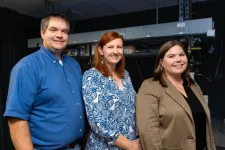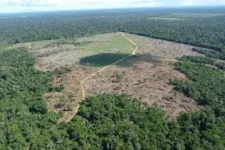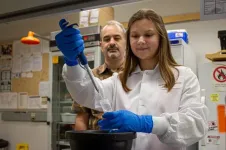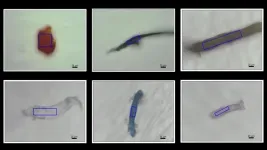(Press-News.org) By Andy Flick, Evolutionary Studies scientific coordinator
In a groundbreaking study led by Sarah Worthan, Ph.D., a postdoctoral researcher in the Behringer Lab at Vanderbilt University, scientists have successfully evolved microbial cultures that possess the ability to sense pH changes, enabling rapid responses to environmental fluctuations. Along with highlighting the power of lab-driven evolution, this discovery also led to finding similar mutations in nature in emerging pathogens and coral symbionts—organisms that navigate challenging pH shifts in their environments and are otherwise difficult to study.
Bratton (left), Behringer (center), and Worthan pose in the lab. (Anthony Czelusniak, VUMC)
The new paper, “Evolution of pH-sensitive transcription termination in Escherichia coli during adaptation to repeated long-term starvation,” was published in the Proceedings of the National Academy of Science on 9/19/24. The driving result from this work is the discovery of a mutation in the independently evolved populations of bacteria that occurs when the bacteria are exposed to feast and famine cycles.
According to the paper, this mutation, where an arginine amino acid is replaced with a histidine, occurred on the Rho protein, which is involved in terminating RNA transcription. Arginine to histidine mutations have also been observed in cancers and have been shown to confer an adaptive pH sensing ability to oncogenic proteins. In bacteria, these arginine to histidine mutations can sense pH and alter the activity of the Rho protein to rapidly impact how genes are expressed.
Evolved in the Lab
Co-author Benjamin Bratton, Ph.D., an assistant professor of Pathology, Microbiology and Immunology at the VU Medical Center, led imaging for the lab experiments and analysis of the pH assays while co-author Marc Boudvillain, Ph.D., CNRS Research Director at the Centre de Biophysique Moléculaire in Orléans, France and a chemist by training, led biochemical experiments demonstrating Rho’s altered activity across pH environments.
A microscopic image showing numerous small, rod-shaped cells.
According to Megan Behringer, Ph.D., assistant professor of Biological Sciences and the principal investigator of the study, “This mutation in rho repeatedly arose in our laboratory evolution cultures. We screened a lot of phenotypes and struggled to identify the Rho mutation’s specific effects. We then reached out to Marc, and he asked if we had considered that the effects might vary with pH. That’s when we returned to our genomic data and noticed that every mutation in rho co-occurred with a mutation in a gene named “ydcI”. Not much is known about this gene, but very recent studies suggested that it may have a role in pH homeostasis. Marc offered to screen our Rho protein in vitro for pH and when he and [co-author] Mildred came back with the results, we began to piece the whole story together.”
“Dr. Behringer reached out to me a few weeks after my lab opened at Vanderbilt with this interesting observation about solution pH, but wondered if there was a way we could measure pH inside individual cells,” Bratton observed. “Measuring single bacterial cell physiology happens to be one of the major skills of the Bratton lab, so this collaboration has been great. Even though bacteria interact with each other through their extracellular environment, individual cells have some control over their intracellular environments.”
Boudvillain added, “we were happy to contribute the biochemistry experiments showing that the Arg-to-His mutation indeed regulates Rho activity in a pH-dependent manner in vitro.”
Found in Nature
After the lab experiments, the team then went to search for these mutations in natural systems.
According to Behringer, “we found it in this neglected pathogen, Bartonella baciliformis, which causes Carrion’s Disease in the Andean valleys of South America. This species of bacteria was already known to pH sense as it must rapidly adjust from the high pH insect gut to the neutral pH of human blood when it’s transmitted by its sand fly vector.”
These results also have implications in the world of marine sponges. According to the paper, the pH of the ocean forms gradients in particular areas, like inside hydrothermal vents or the inside of sponge bodies. Micro-organisms that live in and around these areas need to be able to quickly adapt to both environments. Their evolved gene expression allows this transition; however, climate change could alter these dynamics is serious ways.
“If the ocean pH begins to look more like the sponge pH, this can endanger the bacteria and their symbionts,” Behringer said. “The bacteria may lose the environmental cue that induces the correct behavior for their current environment.”
Collaboration
Boudvillain said that this collaboration started as something of a happy accident. Behringer first reached out to Boudvillain to see a supplemental figure that had disappeared from a website. Upon connecting, the two realized their research trajectories aligned well.
“I was very happy to participate with this interdisciplinary work. I have learned a lot from Ben, Sarah and Megan,” he said. “It has been a great pleasure and opportunity to work with these young and dynamic colleagues.”
Worthan expressed gratitude for a great team, “being part of this exceptional collaborative effort has been incredibly rewarding. Watching this story come together has been the highlight of my postdoctoral experience, and I am thankful to have contributed to such an exciting project.”
Bratton sang a similar tune, “one of Vanderbilt’s core values is radical collaboration, and I think this partnership of different labs bringing their own expertise to the table to understand something more complex and beautiful than any of the labs could have done on their own shows how important radical collaboration is for understanding the (microbial) world as a whole.”
This publication is the culmination of two years of study funded in part by a pilot grant from the original ESI call for applications to Behringer and Bratton. This cross-disciplinary, international collaboration is exactly the type of project that drives Evolutionary Studies at Vanderbilt to new heights.
Citation: Worthan, S.B., McCarthy, R.D.P., Delaleau M., Stikeleather, R., Bratton, B.P., Boudvillain, M., Behringer, M.G. Evolution of pH-sensitive transcription termination in Escherichia coli during adaptation to repeated long-term starvation. 2024. 121:(39) e2405546121
Funding Information: This work used the Advanced Computing Center for Research and Education (ACCRE) and Vanderbilt Cell Imaging Shared Resource (supported by NIH grants CA68485, DK20593, DK58404, 598 DK59637 and EY08126) specifically the Nikon Multi-Excitation TIRF Microscope acquired under S10-OD018075-01A1.
This work was supported by Army Research Office grant W911NF-21-1-0161 (Behringer), National Institutes of Health grant R35GM150625 (Behringer), and French Agence Nationale de la Recherche grant ANR-19-CE44-0009-01 (Boudvillain) Additional funds were provided by Vanderbilt University (startup funds: Behringer), Vanderbilt University Medical Center (startup funds: Bratton), Evolutionary Studies Initiative at Vanderbilt (Behringer and Bratton), and the VUMC Discovery Scholars in Health and Medicine Program (Bratton).
END
Evolved in the lab, found in nature: uncovering hidden pH sensing abilities
2024-09-20
ELSE PRESS RELEASES FROM THIS DATE:
Unlocking the potential of patient-derived organoids for personalized sarcoma treatment
2024-09-20
Investigators at the UCLA Health Jonsson Comprehensive Cancer Center have developed the largest collection of sarcoma patient-derived organoids to date that can help improve the understanding of the disease and better identify therapies that are most likely to work for each individual patient.
The approach, detailed in the journal Cell Stem Cell, uses patients’ own tumor cells that replicate the unique characteristics of a patient's tumor allowing scientists to quickly screen a large number of drugs in order to identify personalized treatments that can target this rare and diverse group of cancers.
“Sarcoma is a rare and complex disease, which makes conducting clinical trials ...
New drug molecule could lead to new treatments for Parkinson’s disease in younger patients
2024-09-20
A novel drug molecule could potentially lead to new treatments to prevent Parkinson’s disease in younger patients, according to new research.
“We are excited about this drug compound because we might have the possibility to develop the first cure for Parkinson’s disease, at least for a subset of patients,” said lead author Kalle Gehring, a Professor in the Department of Biochemistry at McGill University and Canada Research Chair in Structural Studies of Neurodegenerative Diseases.
While Parkinson’s symptoms — slowed movements, tremors and balance problems — often appear in ...
Deforestation in the Amazon is driven more by domestic demand than by the export market
2024-09-20
Brazilian Legal Amazonia (BLA) – which comprises the entirety of the Amazon Basin located in Brazil and vast adjacent swathes of the Cerrado, spanning nine states – is more than 5 million square kilometers (km2) in area and corresponds to almost 60% of the country’s land mass. Almost a quarter of this area (23%) has been deforested, and over 1 million km2 are degraded, so that the region risks reaching an ecological tipping point at which ecosystems collapse and billions of tons of carbon are released into the atmosphere. Some parts of ...
Demand-side actions could help construction sector deliver on net-zero targets
2024-09-20
Using state-of-the-art energy efficiency technologies to renovate existing properties and construct new ones could enable Europe’s construction sector to almost eliminate its carbon emissions by 2060, a new study suggests.
Published in the journal Renewable and Sustainable Energy Reviews, the research is the first to fully assess the potential for energy demand reduction across the construction sectors of the United Kingdom and all European Union member states.
It highlights that 75% of Europe’s building stock is currently classed as energy inefficient, with total floor space also ...
Research team discovers molecular mechanism for a bacterial infection
2024-09-20
Virginia Tech researchers have learned how bacteria manipulate molecules to infect the host organism.
Daniel Capelluto and his research team have discovered the mechanism by which the bacterial pathogen Shigella flexneri, the causative agent of dysentery, manipulates molecular activity to assure its survival against its host’s natural defenses. Their findings were recently published in Structure, a Cell Press journal that supports open access.
“This infection strategy may be employed by other bacteria, making this research a potential foundation for understanding the molecular mechanisms underlying various bacterial infections,” said Capelluto, associate professor ...
What role does a tailwind play in cycling’s ‘Everesting’?
2024-09-20
WASHINGTON, Sept. 20, 2024 – Within the cycling realm, “to Everest” involves riding up and down the same mountain until your ascents total the elevation of Mt. Everest — 8,848 meters.
After a new cycling “Everesting” record was set a few years ago, a debate ensued on social media about the strong tailwind the cyclist had on climbs — 5.5 meters per second (20 kilometers per hour or 12 miles per hour) — when he set the record. To what extent did the tailwind help him? Should limits be set on the allowed ...
Projections of extreme temperature–related deaths in the US
2024-09-20
About The Study: This cross-sectional study found that extreme temperature–related deaths in the contiguous U.S. were projected to increase substantially by mid–21st century, with certain populations, such as non-Hispanic Black and Hispanic adults, projected to disproportionately experience this increase. The results point to the need to mitigate the adverse outcome of extreme temperatures for population health.
Corresponding Author: To contact the corresponding author, Sameed Ahmed M. Khatana, MD, MPH, ...
Wearable device–based intervention for promoting patient physical activity after lung cancer surgery
2024-09-20
About The Study: In this nonrandomized clinical trial, integration of perioperative exercise interventions using wearable devices improved physical activity (especially moderate-to-vigorous physical activity) and dyspnea at 6 months after lung cancer surgery compared with usual care. This finding suggests a promising role for wearable devices in personalizing perioperative rehabilitation strategies.
Corresponding Authors: To contact the corresponding authors, email Danbee Kang, PhD, (dbee.kang@gmail.com) and Hye Yun Park, MD, (hyeyunpark@skku.edu).
To access ...
Self-compassion is related to better mental health among Syrian refugees
2024-09-20
Displaced individuals experience high rates of emotional distress, depression and anxiety resulting from trauma and stress from displacement and loss. Their mental health may suffer further due to a lack of resources, language barriers, and discrimination during resettlement.
A new study by University of California San Diego researchers reports that displaced Syrian refugees with higher reported self-compassion were less likely to report poor mental health outcomes. The study was published in PLOS ONE on September 19, 2024.
Sarah Alsamman, a student at UC San Diego School of Medicine, and Wael Al-Delaimy, M.D., Ph.D., professor of public health at the Herbert Wertheim School of Public ...
Microplastics found in coral skeletons
2024-09-20
Fukuoka, Japan—Researchers from Japan and Thailand investigating microplastics in coral have found that all three parts of the coral anatomy—surface mucus, tissue, and skeleton—contain microplastics. The findings were made possible thanks to a new microplastic detection technique developed by the team and applied to coral for the first time.
These findings may also explain the ‘missing plastic problem’ that has puzzled scientists, where about 70% of the plastic litter that has entered the oceans cannot be found. The team hypothesizes ...





